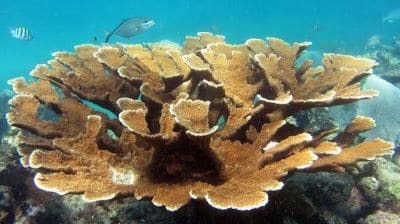Home › Sea Life › Coral Systems › Elkhorn Corals
Facts about Elkhorn Corals
[Phylum: Cnidaria] [Class: Hexacorallia] [Order: Scleractinia (stony corals)] [Family: Acroporidae]
Several global factors (e.g. climate change) threaten the survival of most corals found in shallow tropical reefs and lagoons because it interrupts the symbiotic relationship they have with algae.
This section contains detailed facts and information about elkhorn coral, and the significance of healthy "bush-like" coral species for fish families and other reef organisms.
What Type of Reef is Elkhorn Coral Species?
The common name used for this particular species of coral comes from its resemblance to the branching antlers of male elk (aka wapiti).
From solid bases anchored to the ocean floor, elkhorns start to produce cylinder-shaped branches, almost shrub-like in appearance.
In some regions, thickets of elkhorn coral can grow to two metres high (6 feet) and up to thirteen metres in lateral growth (43 feet).
Other than staghorn coral, not many reef ecosystems grow faster than elkhorns. In fact, the growth rate can be up to ten centimetres a year (4 inches).
For the most part, these fast-growing reef-builders have dull brown or yellow colouring. Even so, other species can have a more vibrant appearance.
Important: Elkhorn corals found at dive sites in southern Florida, Mexico, the Caribbean, and Honduras have the scientific name of Acropora muricata.
Is Elkhorn Coral a Plant or Animal?
In fact, all corals are animals - even though some actually look like they are a plant or a solid rock. These tiny reef producing coral are called polyps and they are examples of marine invertebrates that can create large underwater structures as they grow.
Reef polyps vary in size, but many are as tiny as a pinhead. Even so, they often form large colonies by secreting a hard calcium carbonate shell to create a hard limestone skeleton.
Note: In a nutshell, elkhorn corals are animals. It is alive and, unlike plants, it does not make its own food. Check out another section that answers the popular question of 'what is coral made of' in greater detail.
What Does Elkhorn Coral Need to Survive?
Unfortunately, most elkhorn species (such as staghorn corals) start to die without clear, oxygenated, warm water - and limited wave action.
Thus, you will find these animals more often in sheltered, shallow areas around five metres (15 feet). Nonetheless, healthy species can survive even at depths around thirty (30) metres (98 feet).
 Corals belonging to the Acropora genus use minute, stinging tentacles (cnidocytes) to eat their regular diet 'zooplankton'.
Corals belonging to the Acropora genus use minute, stinging tentacles (cnidocytes) to eat their regular diet 'zooplankton'.
In short, they hunt at night and feed by snatching these tiny aquatic animals that drift in the water column.
Symbiotic Relationships for Extra Nutrition
Most corals can enhance their diet through the absorption of nutrients created by zooxanthellae (single-celled algae).
Algaes convert sunlight into energy, providing additional nutrients for corals to eat. Sequentially, Symbiodiniaceae (photosynthetic symbionts in cnidarians) are happy to use the tissues as a 'safe' place to live.
Interesting Fact: The prefix "phyto" defines the main difference between zooplankton and phytoplankton, as it refers to small plants (e.g. algae, diatoms).
What Eats Elkhorn Coral?
In the main, there are three animal species that prey upon elkhorn corals - coralliophila snails, bearded fireworms (Hermodice carunculata), and some species of damselfish.
Furthermore, large parrot fish species create another threat to elkhorn's existence. They will bite off parts of the branches to get at its prey sheltering within.
Elkhorn Coral Reproduction Process
Being hermaphrodites (bisexual animals) means they have male and female reproductive organs. So, the elkhorn coral is able to reproduce sexually and asexually.
They will reproduce sexually one time per year, usually towards the end of summer. This is when they release huge clouds of eggs and sperm all together into the water column.
Here's the thing:
Colonies of Elkhorn coral do not self-fertilise. They need the sperm from a different colony for fertilisation. Some of the fertilised eggs will develop into coral larvae (called planula) before they eventually settle in the benthic zone to form new colonies themselves.
Because they are one of the fragile coral species, it's common for a broken branch of elkhorn to attach itself to the substrate and start to grow after "asexual reproduction".
Global Threats to Elkhorn Corals
The IUCN Red List of Threatened Species cites elkhorn coral as being Critically Endangered (CR). Research shows that climate change and rising sea temperatures create the biggest threat to its survival (especially through coral bleaching).
These fragile ecosystems are also susceptible to fatal coral diseases (e.g. pathogens, fungi, and bacteria). Some of the most severe spread at an alarming rate, killing entire colonies.
Several other major threats include:
- Humans (e.g. agricultural runoff, fish keeping aquarium trade, dynamite fishing, tourism).
- Hurricanes
- Invasive fish species (e.g. crown-of-thorns starfish, lionfish)
- Ocean acidification
- Underwater garbage pollution
Elkhorn Coral Lifespan
One of the lesser known facts about elkhorn coral is that it has a low resistance and tolerance to bleaching. Thus, it often takes longer to recover than other coral classifications.
Bleaching results in the removal of algae, which turns corals white. Despite being 'alive', this state renders it less resistant to stress and disease.
In general, it takes three to five years of growth for elkhorn coral to mature. Studies suggest the generation length is around ten (10) years. In fact, healthy polyps can live for over one hundred years.
Related Information and Help Guides
- How Do Artificial Reefs Help the Environment and Marine Life?
- Staghorn Coral Facts and Information with Examples
- What is Coral? Is it a Rock or a Plant or a Mineral?
- Porites Stony Finger Coral Species Facts and Information
Note: The main section lists 10 simple steps to saving coral reefs and how daily decisions and actions can make a difference.